|
THE FAIRFORD BRANCH LINE |
|
|
|
KELMSCOTT & LANGFORD |
|
The GWR were being optimistic when in 1907 they christened their new station Kelmscott & Langford, for although Langford was only
a mile north of the station, Kelmscott was 2 miles
away! With the exception of Yarnton (Which I doubt would have been built except for its junction status), Kelmscott & Langford was the least used station on the line. Situated in the sparsely populated flat countryside
16 miles 3 chains from Yarnton, even now it has a distinct feeling of remoteness. Probably because of this isolation, the site (SP253018) retains more relics than most Fairford Branch stations. As well as the road
overbridge, the platform, one of the tall lamp posts & the cattle dock all still exist. Although an attempt was made to clear the site of vegetation a few years ago, nature has reclaimed the site and at the present time
(August 2004) the area in front of the platform is an impenetrable mass of brambles.
|
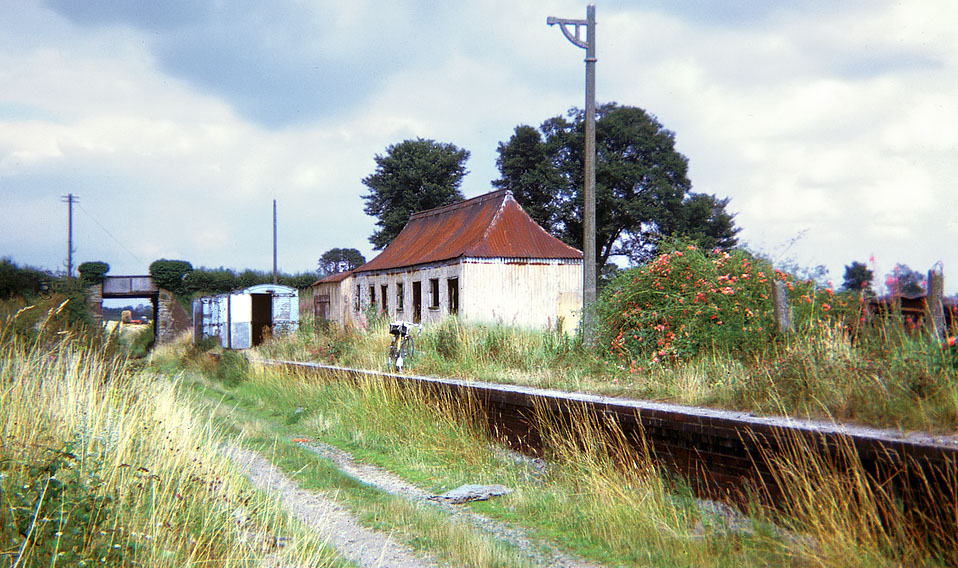 |
|
Kelmscott & Langford station as I remember it from childhood cycle rides. This time however, the bike on the weed grown platform belongs to Stanley Jenkins! It is 10 August 1972 and
the enlarged GWR pagoda hut that served as the station building is still in situ, as is the adjacent store. Two early BR containers have also been deposited on the platform for use as agricultural storage. The rose bush by
the lamp post has got a little out of control after ten years without any pruning! Harvesting is underway in the field on the other side of the bridge.
Stanley C. Jenkins
|
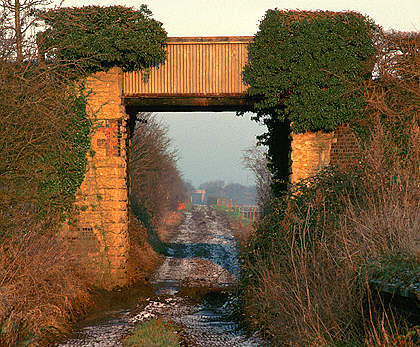 |
The last rays of the setting sun illuminate the road overbridge at Kelmscott & Langford on 12 January 1985. This telephoto view flattens the perspective, clearly showing Calcroft
Lane bridge in the background. The trackbed between the two bridges is now a public bridleway, although the dip under the bridge is usually flooded, sometimes to such a depth as to make access very difficult. The
embankments for all the EGR bridges were built as cheaply as possible, this became evident a couple of years ago when a large void appeared in the road on the Langford side of this bridge! The station platform can be seen
on the right of the picture.
Martin Loader
|
|
The village of Langford is chiefly noted for its church, which has a fine late Saxon tower and equally rare Saxon carving on the wall of the porch. Although a small farming community
now, the relatively large size of the church implies that a thousand years ago it was considerably more important. If Langford is for the most part tourist free, the same cannot be said of Kelmscott, which thanks to its
connection to William Morris, the late Victorian poet, Socialist & designer, receives a steady stream of visitors. It also has the added attraction of being situated next to the River Thames. |
|
This fine Edwardian photograph depicts the building of Kelmscott & Langford station during the summer of 1907. Footings have been excavated for the platform, and bricks have been
unloaded from the train in the picture and can be seen scattered in piles on the left of the picture. Meanwhile, the coping stones for the new platform are stacked against the hedge. An open cabbed loco can just be seen at
the far end of the train. As can be seen, the track layout was not altered, and it was not until 1928 that a single siding was added for freight traffic.
P. Cooper |
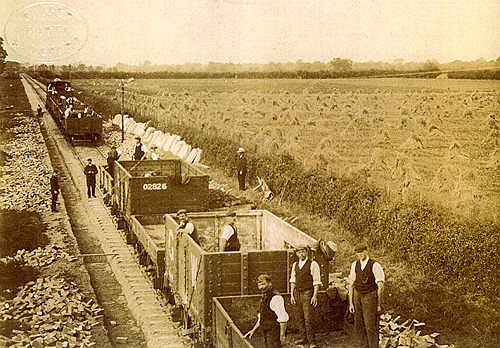
|
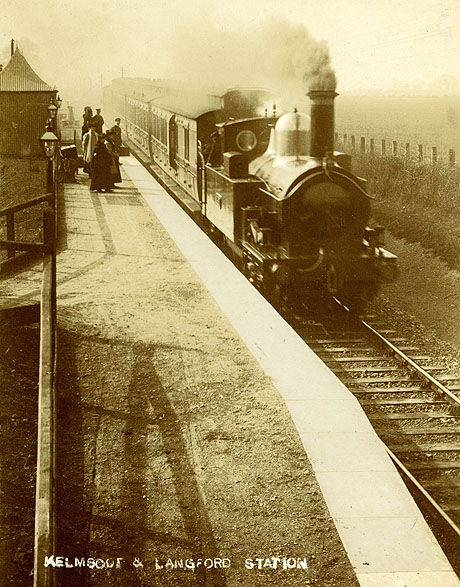 |
A GWR 455 'Metro' Class 0-4-2T arrives at the relatively new Kelmscott & Langford station in around 1910-12, with what is, judging by the angle of the sun, the 11:50 Fairford to Oxford train. This sepia image is from an original
postcard in my collection, which was presumably published by the local photographer, P. Cooper. Not the best quality image, with the photographer's camera being unable to completely stop the slow movement of the loco. However, there is plenty of interest in this historic view,
with the ladies in Edwardian dress in the background, waiting to travel with what looks like a considerable amount of luggage, and a 17 gallon milk churn waits to be loaded onto the train at the far end of the platform. Note the inside keyed track in the foreground. The postcard
was posted at Lechlade in May 1912 to an address in Westrop, Highworth.
Martin Loader Collection
|
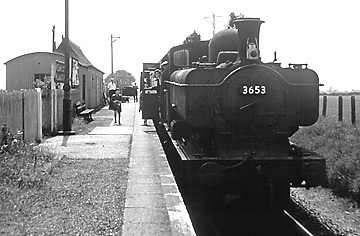 |
57xx Class 0-6-0PT 3653 waits to leave Kelmscott & Langford with a train for Oxford in June 1962. This was one of the regular branch engines during the final years. It survived as
an Oxford (81F) allocated engine until withdrawal in October 1963. It was broken up in Swindon Works in February of the following year. Unfortunately an afternoon up train means the photographer is shooting straight into
the sun, resulting in a loss of detail on the front of the loco (tweaked up as much as possible in Photoshop!)
John Strange |
|
Kelmscott & Langford Station on 29 September 1956. The photographer on the bridge is joined by another by the fence on the right, surely unaccustomed photographic activity for
such a small station in the 1950s! Presumably the typical 1950s station wagon (as they were called then) on the left is theirs and does not belong to one of the few passengers to use this station, who virtually all came on
foot or by bicycle. The station is still neat and tidy on this date, with all fences and gates intact, and even some traffic in the single siding. Note how the siding is built up to platform level, with the vans on the end
of the rake of wagons dipping down towards the point with the running line. This view also highlights how isolated the station was, with no buildings in view.
Martin Loader Collection |
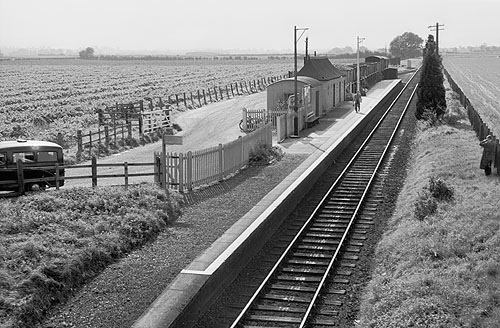
|
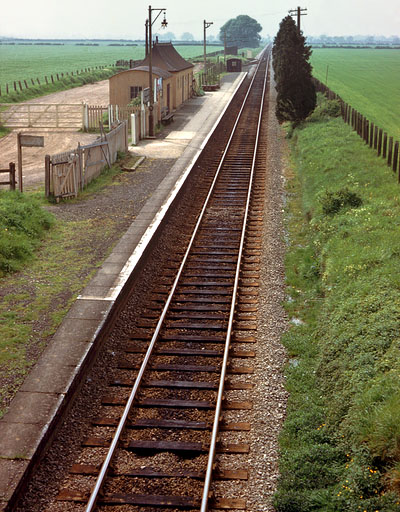 |
Kelmscott & Langford station is pictured (left) in the early 1960s, looking towards Lechlade. Very similar to the 1950s view, but now beginning to look a little less tidy. On the original Kodachrome
slide a man can be seen standing next to the ground frame hut in the background. As this is near the PW hut (which can just be seen in front of the large tree), he is probably a lengthman. Otherwise
there is not a single
person in view. Other signs of neglect include the fact that the
lit Tilley Lamp is still hoisted up its post despite the fact that it
is obviously near midday.
Colour Rail |
|
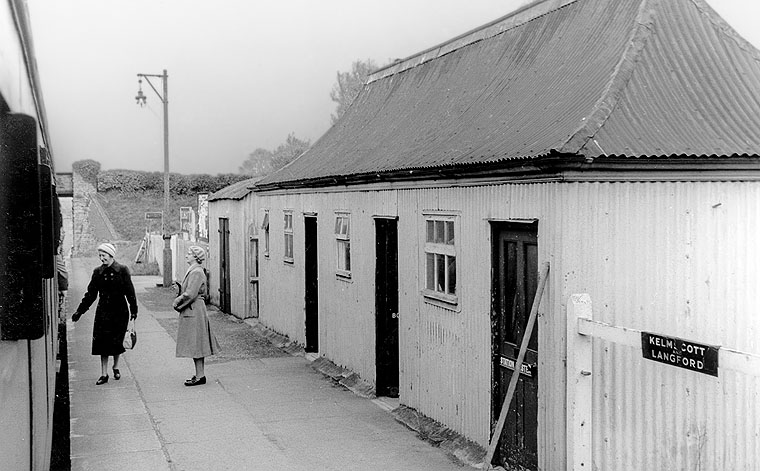
|
|
A close up view of Kelmscott & Langford station building on 12 May 1962, with at least one, if not two passengers! Note the non-standard Kelmscott & Langford nameboard fixed to the fence in the
foreground. Signs for the Station Master's room and the Booking Office can be seen on the two nearest doors. The ivy which became such a feature of the bridge in the background has already started to take hold. Compare the
amount of growth with the two pictures below.
Martin Loader Collection |
|
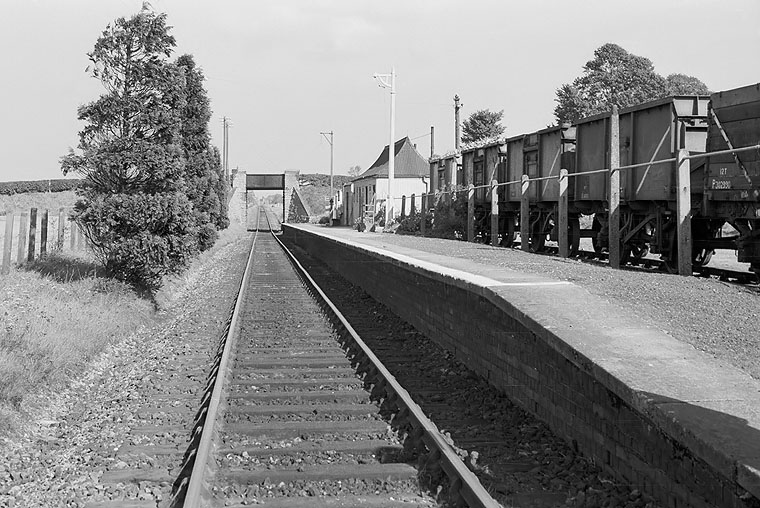
|
|
A fine view of Kelmscott & Langford station taken on 29 September 1956. As well as being a good general view of the small station, a couple of interesting points are evident. The
dip in the track under the bridge can clearly be seen, and although the preceding month had been one of the wettest on record, there doesn't seem to be any evidence of the usual floods. However, the main point of interest in
this photo is the inclusion of a line of wagons in the siding, with wooden 12 ton wagon P302990 leading a rake of four 16 ton steel bodied opens, the furthest two of which contain what appears to be sugar beet. The most
unusual feature of the siding is that the rail level appears to be virtually at platform surface level.
Martin Loader Collection |
|
Two views of the trackbed near to the road overbridge at Kelmscott & Langford. The picture on the left shows the extent of the flooding that was once commonplace under the EGR bridges. This is the view
from the bridge looking towards Alvescot, as seen on 19 April 1980. Admittedly this is an extreme example, with the whole track flooded to some depth, and an even deeper hole by the side of the track (the dark area on the
right). On 30 May 2012 the location was much drier, as the view on the right, looking the other way towards the bridge shows.
Martin Loader & Stanley C. Jenkins |
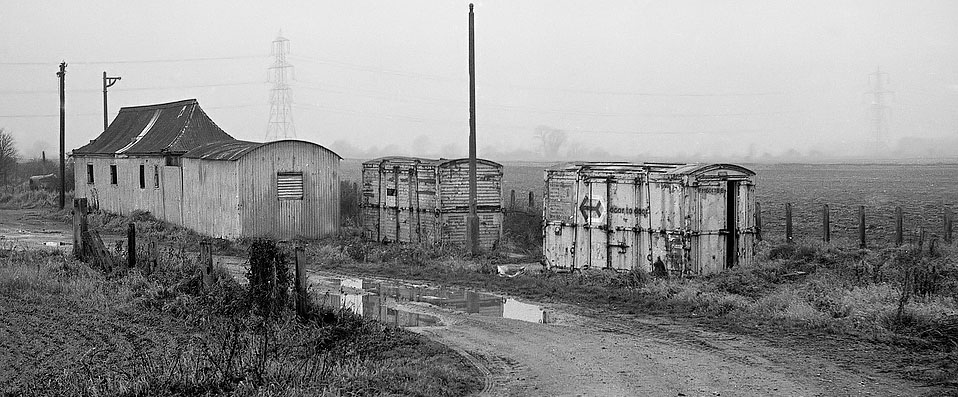 |
|
A view of the road approach to Kelmscott & Langford station taken on a very misty winter day sometime around 1970. This clearly shows the two early BR Containers that had presumably
been acquired by the local farmer for use as storage.
Martin Loader Collection
|
|
During early 1980, the surviving bridges had their mileage from Paddington crudely scrawled on the brickwork. The bridge at Langford displays 83 miles 28½ chains on 19 April 1980.
Rampant ivy growth has obscured this in recent years, but by August 2003 this had been removed. Faint traces of the numbers can now be seen (southern abutment, western side). Curiously the GWR bridge register places
this bridge at 83 miles 27 chains, presumably the 33 yards discrepancy is due to platform remodeling at Paddington.
Martin Loader
|
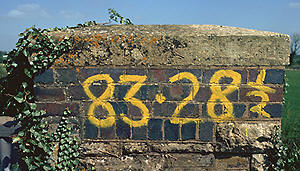
|
|
Looking a little worse for wear, but still largely complete, the cattle dock is pictured on 23 March 2003, with the station site in the background. This cattle dock was the only
goods facility available at the station, served by a lengthy siding that trailed into the main line in the down direction. Despite purporting to serve a large agricultural hinterland, and probably not helped by the poor
facilities, traffic levels were always poor.
Martin Loader
|
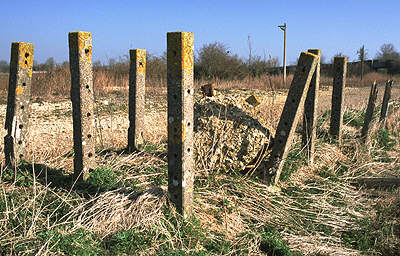 |
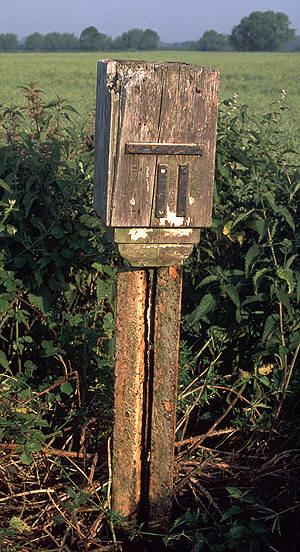 |
A remarkable survivor, milepost 83¾ is pictured on 15 June 2003, almost 41 years to the day since the line closed. This is one of the last surviving posts complete with its
head and remains of the cast metal numbering. These standard GWR design posts replaced the earlier circular cast iron posts, an example of which can be seen in the Witney & District Museum. At about this point the
line starts its gentle right hand curve that brings it onto an east - west alignment by the time it reaches Lechlade. To the south of the line at this point was the site of RAF Kelmscott - a wartime relief landing
ground attached to RAF Brize Norton. It was principally used for parachute drops and pioneering experiments in blind approach landing. This section of the trackbed is now a public right of way, with another footpath
crossing the route ½ mile west of the station site (SP247013). A further ½ mile brings you to the bridge spanning the Langford Brook (SP243009). This has a 5 ft 10 in span between stone & brick abutments.
Martin Loader
|
|
1½ miles after leaving Kelmscott & Langford we come to the site of Little Faringdon level crossing (SP234005). Why this was the only level crossing on the East Gloucestershire
Railway remains something of a mystery, especially as the numerous road overbridges were built so cheaply and the terrain was so flat that level crossings would have been the normal choice. The East Gloucestershire Railway
provided a crossing keeper's cottage in the same style as their station buildings, constructed from the local stone, with brick quoins. |
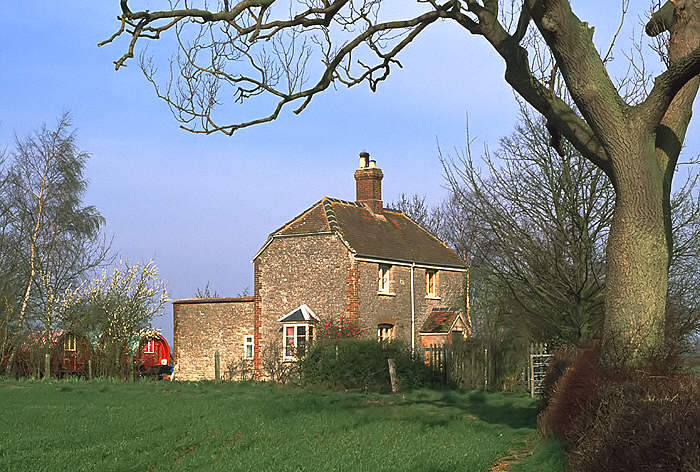 |
|
This view (above) shows the crossing keeper's house on 17 March 1990, when it was still largely in its original condition, although the cabin containing the ground frame which
controlled the crossing had gone. This stood in the garden in front of the house. Note the bay window which gave a good view of the line in both directions.
Martin Loader |
|
Two further views of the crossing keeper's cottage. The view on the left shows the building on 10 August 1972, this time seen from the rear of the building, looking along the course of the line towards
Kelmscott & Langford. Although the gates have gone, the posts are still there, and of course the ground frame hut hadn't yet been removed, and at this time still retained its original stove pipe chimney. The
picture on the right (23 March 2003) is taken from the site of the level crossing and shows the course of the line heading off towards Lechlade. Note that the bay window has now gone and the building has been considerably
extended at the rear.
Stanley C. Jenkins & Martin Loader |
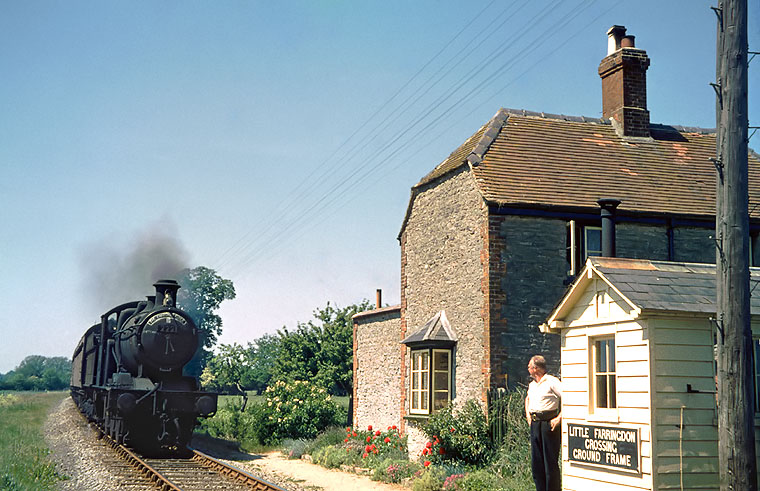 |
|
Pictures of trains in the vicinity of Little Faringdon Crossing seem to be extremely rare, but here is a superb view of 22xx Class 0-6-0 2221 approaching the crossing with the 12:32
Fairford to Oxford train on 8 June 1962. With only just over a week to go before the line's closure, the loco carries the chalked inscription 'The Fairford Flyer' on the smokebox door. A fascinating picture taken on a
perfect summer's day, with the crossing keeper looking on and the peonies in full bloom in the trackside flower border. Note the spelling of Little Faringdon Crossing Ground Frame. This seems to be the GWR subtly altering
the spelling, as happened at various other locations. Virtually all other sources show the village name as Little Faringdon. Directly behind the locomotive is one of the stately elm trees that were such a feature of the
Oxfordshire landscape until the coming of Dutch Elm Disease in the decade after the Fairford Branch closed. Another point to note in these health and safety conscious days is the complete lack of any separation between the
crossing keeper's garden and the track. Obviously as the public had not access to this point there was no legal requirement to have it fenced, but nowadays it would be fenced off and numerous notices would warn rail
employees of the hazard!
Howard Burchell |
|
The ground frame cabin was still in situ on 23 April 1984. This housed the three levers that controlled the level crossing locking bolt and the two ATC ramps that protected the
crossing (All distant signals having been removed in 1906). When the track on this section was lifted in 1964, the rails were left in the road, merely being tarmaced over, but recent investigation with a metal detector
(thanks Malc!) has failed to locate any sign of them now.
Martin Loader |
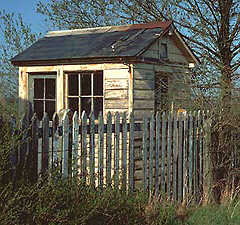 |
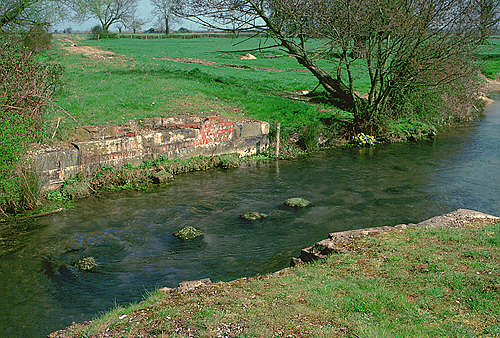 |
A short distance after Little Faringdon crossing, the line crossed the River Leach on a twin span girder bridge (SP229004), each span being 8 ft 3 in (9 ft 6 in on the skew) wide. In
this 19 April 1980 view, looking east, the bases of the central piers can be seen in the river. Originally these would have been timber piles. To quote from the GWR bridge register: "The whole of the timber is in very
poor condition & extensive renewals are required. Work authorized 6 March 1906, renew timbers £100." From here the line continued on a curve towards Lechlade station, passing over numerous culverts and another
small twin span girder bridge over a backwater of the River Leach.
Martin Loader |
|
On 22 April 2006, a small section of a girder from the River Leach bridge could still be seen abandoned next to the railway fence on the north side of the line, just to the west of
the River Leach. It is the section that rested on the brickwork abutments, and you can clearly see where it has been cut from the remainder of the girder. The black paint is sill extant, except where the heat from the
oxy-acetylene cutter has burnt it away. Why this one small section was not removed with the rest of the steelwork is a mystery.
Martin Loader |
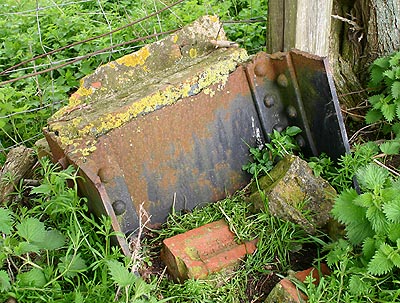 |
 |
All along the branch, numerous gates were provided giving farmers access to fields on either side of the line. This surviving example a short distance west of the River Leach
(SP228004) shows the standard construction: a wooden gate between two concrete posts, with reinforced rail sections used to terminate the post and wire fence. On 22 April 2006 the sheep come to investigate the unexpected
appearance of a photographer at this difficult to get to section of line!
Martin Loader |
|